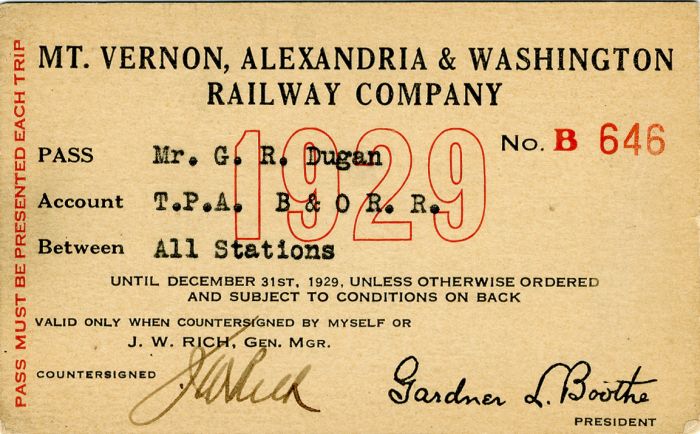Mt. Vernon, Alexandria and Washington Railway Co. Railroad Pass - Americana
Inv# AM1829
Railroad Pass for the Mt. Vernon, Alexandria and Washington Railway Company. Measures 3 3/4" x 2 3/8".
In relation to Mt. Vernon, Alexandria and Washington Railway, the Washington, Alexandria, and Mount Vernon Electric Railway began operating between Alexandria and Mount Vernon in 1892. On August 23, 1894, it was given permission to enter the District of Columbia using a boat or barge. However, the railroad never actually used any such watercraft.
The railroad completed its tracks in 1896 and began serving a waiting station at 14th Street NW and B Street NW in downtown Washington, D.C. From the waiting station it used the Belt Line Street Railway Company's tracks on 14th Street NW to reach the Long Bridge, a combined road and rail crossing of the Potomac River.
In 1902, the railroad moved its station, as the Belt Line's tracks were circling the block containing the site of a planned new District Building (now the John A. Wilson Building). The new station (address: 1204 N. Pennsylvania Avenue) extended along Pennsylvania Avenue, NW, and D Street, NW, from 12th Street, NW, to 13 1/2 Street, NW, near the site of the present Federal Triangle Metro station and on the opposite side of 12th Street from the Old Post Office building.
In 1906, the Long Bridge's streetcar tracks and road were relocated to a new truss bridge (the Highway Bridge), immediately west of the older bridge. This span was removed in 1967.
After crossing the Potomac River, the trolleys entered Arlington County (named Alexandria County before 1920) to run southward near and along the present route of Interstate 395 (I-395). They then reached Arlington Junction, whose site is now in the northwest corner of Crystal City west of Richmond Highway (U.S Route 1) and south of The Pentagon and I-395. At the Junction, the line's route diverged from that of a line that traveled west to Fairfax City and which connected to others that served Arlington National Cemetery, Rosslyn and Nauck.
After leaving Arlington Junction, trolleys on the Washington-Mount Vernon line continued south along the present route of S. Eads Street while travelling largely on the grade of a towpath on the west side of the defunct Alexandria Canal. Near Arlington's present southern border at Four Mile Run, the railroad and its affiliates constructed an amusement park (Luna Park) and a rail yard containing a car barn and a power plant.
After crossing Four Mile Run into present-day Alexandria, the trolleys continued to travel south along the present route of Commonwealth Avenue. The Mount Vernon line then passed under a bridge at St. Elmo that carried the Bluemont branch of the Southern Railway and later the branch's successor, the Bluemont Division of the W&OD Railway. The lines' St. Elmo stations, located in Alexandria's present Del Ray neighborhood, gave travelers an opportunity to transfer between the railroads.
The Mount Vernon line's trolleys then continued southward along Commonwealth Avenue until reaching King Street near Alexandria's Union Station. The line's trolleys then turned to travel east on King Street until they reached a station at Royal Street, in the center of Old Town Alexandria next to Market Square. They then turned again, traveled south on S. Royal Street and crossed Hunting Creek to enter Fairfax County on a 3,500 feet (1,067 m)-long bridge containing a concrete and steel center span and trestle.
After traveling through New Alexandria, where the line had originated, the trolleys continued south through Fairfax County at speeds of up to 30 miles (48 km) per hour while traveling partially along the present routes of the George Washington Memorial Parkway, East Boulevard Drive and Wittington Boulevard. After crossing Little Hunting Creek, they reached a turnaround loop on which they traveled to a terminal constructed near the entrance to the grounds of George Washington's home in Mount Vernon.
At Mount Vernon, when the electric railway began service, the estate's proprietors insisted that only a modest terminal be constructed next to the trolley turnaround. They were afraid that the dignity of the site would be marred by unrestricted commercial development and persuaded financier Jay Gould to purchase and donate thirty-three acres outside the main gate for protection.
By 1906, the railway had transported 1,743,734 passengers along its routes with 92 daily runs. Passengers and others could read a 122-page Hand-book for the Tourist Over the Washington, Alexandria and Mount Vernon Electric Railway that described in detail the railway's routes and stations as well as the landmarks, history and geography of the area through which the railway traveled.
In 1913, the Washington, Alexandria, and Mount Vernon Electric Railway merged with the Washington, Arlington & Falls Church Railway to form the Washington-Virginia Railway. During World War I, the railroad company extended the Washington-Mount Vernon line to Camp Humphreys (now Fort Belvoir). As the company received only partial compensation for constructing the extension, the action placed a financial burden on the company. The company went into receivership in 1923 when buses became the dominant form of local public transportation (see: History of surface transit in Northern Virginia).
In 1927, the two railways were separated and sold at auction, the Washington-Mount Vernon line becoming the Washington, Alexandria and Mount Vernon Railway. The last trolleys of the line ran on January 18, 1932. Later that year the tracks were removed when some of the right-of-way was used for the George Washington Memorial Parkway. The path of the trolley turnaround at Mount Vernon remains as a traffic circle at the south end of the Parkway, while the former rail yard in southern Arlington now serves as a Metrobus yard.









Ebay ID: labarre_galleries